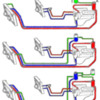this is what I have recently gathered from reading postings on this site
IF you have the original configuration;
tank A would be surge or swirl tank. it has the radiator cap so that when pressure exceeds 15 psig the expanded coolant is vented into tank B
Tank B would the the recovery. the hot coolant that enters will be sucked back into the swirl tank as the system cools. the cap on the recovery should allow air to easily come in and out of the tank.
You DO NOT want any air in the circulating coolant. entrained air reduces the thermal conductivity and promotes corrosion. the purpose of the swirl is to spin out bubbles, let them collect under the radiator cap and when it relieves, the air will be vented to the recovery tank
the top configuration is the original.
the second configuration has converted tank B into an expansion tank. the pressure relieving cap is removed from swirl and placed on top of expainsion. the top of the swirl (and shown, the top of radiator reversing tank) are vented into the expansion tank. the bottom of the expansion tank is connected to the water pump suction. the air that enters mixed with the vented coolant will accumulate above the coolant under the relieving cap. this arrangement now has the radiator cap relieving pressure that of pump suction, not of pump discharge like original configuration.
for an expansion tank, the amount of air when cold changes the temperture pressure relationship. if the volume is greater than 2 expansion volumes, the pressure when hot will be less than 15 psig.
the bottom configuration converts the expansion tank into a header tank. the differance is NO AIR within the pressurized coolant system. a resevior tank would be need so that when the cap relieves the expained coolant, it can be sucked back in when cooling. with no air in the pressurized system, as soon as the coolant begins to expand, the pressure quickly reaches 15 psig of the cap relief.
I am considering a fourth configration not shown. besides using the swirl tank to spin out air bubbles, I am thinking about using heater core flow into header tank to deaerate the warmup sweeping of the block and heads.
EDIT...reply to the two post while I was composing.
the pressure in the swirl tank will be higher than the pressure at the radiator so venting the radiator does not seem to be possible
in my illustrationa, the expansion tank would be at the lowest pressure in the system (pump suction) so the reversing tank on the radiator will have a higher pressure to assist venting


